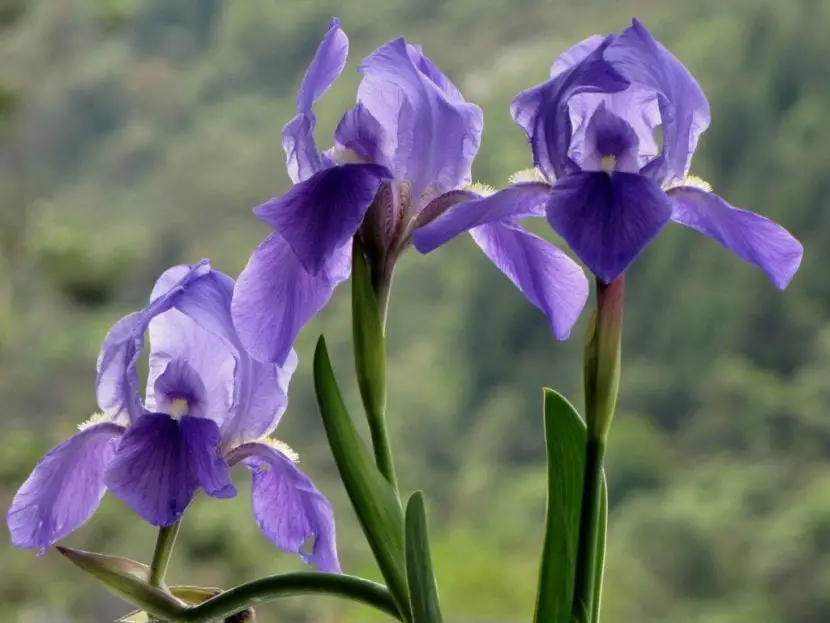
One of the most common bulbous plants in gardens, but no less beautiful, is the German iris. And it is that in addition to having a high ornamental value, it is one of those species that is really easy to care for, whether it is kept in the ground or in a pot.
Meeting her is a pleasure, since allows you to discover its characteristics and, also, all its secrets. So let’s go.
Origin and characteristics of German iris

Our protagonist is a perennial rhizomatous plant native to Germany known as Blue Lily, Cardinal Lily, Common Lily, Purple Lily, Easter Lily, and Bearded Lily. It is characterized by having basal, linear leaves whose height is between 3 to 40cm by about 3cm wide. The scented flowers appear distributed in inflorescences that sprout from a terminal stem with leaves at the base. Each flower has three glabrous, ovate, outward-curving sepals and three erect petals that fold over the fertile part of the flower. Blooms from spring to summer.
It has a fairly fast growth rate, so much so that there are those who consider it a bit invasive. Now, being a rhizomatous it is a plant that can be easily controlled.
What are their cares?
If you want to get a copy, we recommend providing the following care:
Location
You can have it both in full sun and in semi-shade, but it is important not to place it in shade since otherwise it will not produce flowers or they will be very scarce.
Earth

- the garden: grows in fertile and well-drained soils.
- Flower pot: use universal growing medium mixed with 30% perlite or washed river sand.
Irrigation
It must be watered once or twice a week, avoiding waterlogging at all times. In case of having it in a pot with a plate placed underneath, we have to remember to remove the excess water ten minutes after watering to avoid rotting of its root system.
Subscriber
It is not necessarybut to stimulate its flowering we can fertilize it with a specific fertilizer for bulbous plants following the indications specified on the product packaging.
Planting or transplanting time
Considering that it blooms in spring we have to plant it in autumn. If we are going to have them in a pot, it is advisable to transplant them every two years, since over time their rhizomes will grow more producing new plants.
Multiplication
It multiplies by seeds and by separation of rhizomes in spring. Let’s see how to proceed in each case:
Seeds
To sow your seeds you have to do the following:
- The first thing to do is fill a 10,5cm pot with universal growing medium mixed with 30% perlite.
- Afterwards, we water and spread a maximum of 4 seeds on its surface.
- Then we cover them with a very thin layer of substrate.
- Finally, with the help of a sprayer we moisten the surface of the substrate.
Placing the pot outside, in semi-shade, and always keeping the substrate, the seeds moist (but not waterlogged) will germinate in 15-30 days.
Rhizomes
To multiply it by rhizomes you have to follow this step by step:
- First, we take it out of the pot or make trenches of about 30cm around if we have it on the ground.
- Afterwards, we carefully cut the rhizomes that have a manipulable size.
- Finally, we plant them in other corners of the garden or in pots with universal growing substrate mixed with 30% perlite.
That spring will sproutalthough to help them we can water with homemade rooting agents.
Pests

- Aphids: they feed on flower buds. They are controlled with sticky yellow traps. See file.
- Trips: They are like small earwigs that feed on new leaves, where brown and black spots appear. We can fight them with Fluvalinate. See file.
- Molluscs: snails and slugs they can destroy the Iris germanica. They are fought with molluscicides.
Diseases
- Roya: it is a fungus that manifests itself with the appearance of reddish-brown pustules. It is fought with fungicide. See file.
- Botrytis: it is a fungus that manifests itself with the appearance of a gray powder or mold on leaves and flowers. It is fought with fungicide.
- Fusarium: it is a fungus that is manifested by the wilting and subsequent death of the leaves. It is fought with fungicide. See file.
- Virus: they are viruses that produce mosaics in leaves and flowers. There is no treatment.
Pruning
Dry leaves and withered flowers must be removed.
Rusticity
The German iris it resists well cold and frost down to -15ºCso that we can have it all year long abroad.
For what do you use it?
Ornamental
The common lily is a very pretty bulbous, ideal for decorating any more or less bright area of the garden or patio. It can be both in a pot and in the ground, combining it (or not) with other bulbous plants of a similar size, such as tulips.
Medicinal
The juice of its root can be used as a purgative.

What did you think of this beautiful plant?
